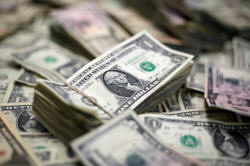Dollar slides further as euro rallies towards $1.20
 Send a link to a friend
Send a link to a friend
 [May 14, 2018]
By Tom Finn [May 14, 2018]
By Tom Finn
LONDON (Reuters) - The dollar headed for its fourth successive day of
losses on Monday as broad risk appetite returned and investors
questioned whether a recent rally by the greenback had run out of steam.
The dollar index against a basket of six major currencies hit a
4-1/2-month high last Wednesday, as a rise in U.S. Treasury yields
highlighted the wide interest rate gap between the United States and
other countries.
But the surge was stymied by soft April U.S. consumer price data
published last week that introduced doubts about expectations that the
Federal Reserve would raise rates as many as four times in 2018.
The index <.DXY> fell 0.3 percent on Monday to 92.402, backing further
away from last week's 2018 peak.

Growing worries about the U.S. budget deficit, which is projected to
balloon to more than $1 trillion in 2019 due to a government spending
splurge and large corporate tax cuts, have also undermined the dollar
along with concerns about the country's current account deficit.
"Barring a significant, and unlikely, pickup in productivity, a
persistent USD rally is unlikely as the twin deficits crowd out private
investment by raising borrowing costs," said Hans Redeker, global head
of currency strategy at Morgan Stanley in London, in a note.
Economists say President Donald Trump's tax cuts and spending plans
could backfire by overheating an already strong economy and causing an
unwanted pick-up in inflation.
The euro, meanwhile, headed for a third successive day of gains on
Monday encouraged by the weaker dollar.
The single currency crept higher even as investors kept a wary eye on
political events in Italy.
Italy's anti-establishment 5-Star Movement and the far-right League,
both hostile to European Union budget rules, spent the weekend in talks
to forge a common policy program. The parties were adversaries as
recently as March but now look likely to form Italy's next government.

[to top of second column] |

U.S. Dollar banknotes are seen in this photo illustration taken
February 12, 2018. REUTERS/Jose Luis Gonzalez/Illustration/File
Photo

The euro <EUR=> gained 0.4 percent to $1.1986, having fallen last week to
$1.1823, its weakest since Dec. 22.
"Italian politics aren't a major moving factor in the euro zone yet. It's not an
existential threat and isn't driving a lot of positioning," said Manuel Oliveri,
an FX strategist at Credit Agricole in London.
"I expect inflation to rebound in the euro zone and that will keep the European
Central Bank's stimulus unwinding on track," he said.
A loss of economic momentum in Europe has made policymakers in the euro zone and
Britain more cautious about ending the era of extraordinary monetary stimulus.
On Friday, ECB President Mario Draghi said the euro zone needed a new "fiscal
instrument" to help weaker member nations if they were being overly penalized by
investors during a debt crisis.
Traders pushed out expectations of a rate rise in Britain to end-2018 and in the
euro zone to the second half of 2019.

Analysts at ACLS said they expected a reduction in trade tensions between the
United States and China to fuel risk-on sentiment this week that would be
positive for the Australian dollar and negative for the yen, considered a
safe-haven currency.
The Australian dollar rose 0.1 percent to $0.7558 <AUD=D4> after rallying back
from an 11-month low of $0.7413 plumbed on Wednesday.
Investors are focused this week on speeches by Fed and ECB officials, as well as
German data on Tuesday that is expected to show some slowdown in economic
growth.
(Editing by John Stonestreet and David Stamp)
[© 2018 Thomson Reuters. All rights
reserved.] Copyright 2018 Reuters. All rights reserved. This material may not be published,
broadcast, rewritten or redistributed.
Thompson Reuters is solely responsible for this content. |